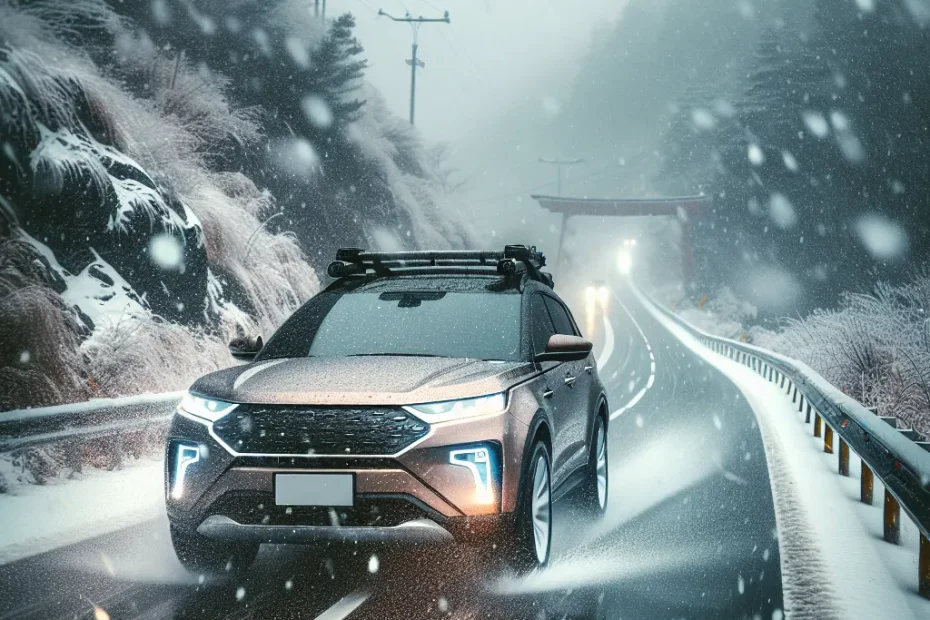As we navigate the roads in Korea, we often encounter various challenges posed by inclement weather conditions such as rain and snow. Driving in such conditions requires not only skill but also preparedness. Preparing your vehicle for inclement weather, knowing how to drive safely in rainy conditions, and navigating snowy roads with confidence are essential aspects to consider. Additionally, being equipped with emergency preparedness for unforeseen weather challenges can make all the difference in ensuring a safe journey. In this blog post, we will explore these key tips to help you drive safely and confidently in adverse weather conditions in Korea.

Preparing Your Vehicle for Inclement Weather
As we face the challenges of driving in inclement weather, it is crucial to ensure that our vehicles are adequately prepared to navigate through rain and snow in Korea. Proper preparation can make a significant difference in ensuring safety on the roads. Here are some essential tips to help you get your vehicle ready for any weather conditions that may come your way:
1. Check Your Tires
One of the most critical aspects of preparing your vehicle for inclement weather is ensuring that your tires are in top condition. Make sure your tires have sufficient tread depth to provide proper traction on wet or snowy roads. Consider switching to winter tires for better performance in snow and ice.
2. Inspect Your Brakes
Your brakes are your best friend in challenging weather conditions. Have your brakes inspected regularly to ensure they are functioning correctly. Slick roads require optimal braking capabilities to prevent accidents.
3. Replace Worn Wiper Blades
Clear visibility is paramount when driving in rain or snow. Replace worn wiper blades to ensure that your windshield stays clear of precipitation. Consider using winter wiper blades designed to handle heavy snowfall.
4. Top Up Fluids
Check and top up essential fluids such as windshield washer fluid, antifreeze, and oil. These fluids play a crucial role in keeping your vehicle running smoothly in adverse weather conditions.
5. Battery Check
Cold weather can take a toll on your vehicle’s battery. Have your battery tested to ensure it is in good condition and can withstand the demands of winter driving.
6. Emergency Kit
Prepare an emergency kit to keep in your vehicle in case of unexpected situations. Include items such as a flashlight, blanket, first aid kit, water, snacks, and a shovel to help you during emergencies.
7. Check Lights
Ensure all your vehicle lights are working correctly, including headlights, taillights, brake lights, and turn signals. Proper lighting is essential for visibility in low-light and adverse weather conditions.
By following these tips and adequately preparing your vehicle for inclement weather, you can enhance your safety and that of others on the road. Remember, being proactive and taking the necessary precautions can make a significant difference in how you navigate through rain and snow in Korea. Stay safe out there! 🌧️❄️🚗
Tips for Driving Safely in Rainy Conditions
1. Slow Down and Increase Following Distance
When driving in the rain, it’s important to reduce your speed and increase the distance between you and the vehicle in front of you. Hydroplaning can occur at speeds as low as 35 mph on wet roads, so slowing down can help prevent this dangerous situation.
2. Ensure Proper Tire Tread and Pressure
Proper tire maintenance is essential for driving safely in rainy conditions. Tires with good tread depth can disperse water more effectively, reducing the risk of hydroplaning. Additionally, maintaining the correct tire pressure can improve traction on wet roads.
3. Use Your Headlights
Visibility is significantly reduced during rainy weather, so it’s crucial to use your headlights, even during daylight hours. This not only helps you see better but also makes your vehicle more visible to other drivers. Remember, wipers on, lights on!
4. Avoid Sudden Maneuvers
Abrupt movements such as quick turns or sudden braking can be extremely dangerous on wet roads. Make gradual movements and anticipate stops well in advance to avoid skidding or losing control of your vehicle.
5. Stay Alert and Avoid Distractions
Driving in the rain requires your full attention. Avoid distractions such as using your phone or adjusting the radio. Stay focused on the road ahead and be prepared for sudden changes in traffic conditions.
6. Be Mindful of Standing Water
Puddles and standing water on the road can be deceivingly deep and hide potholes or debris. Try to drive around standing water whenever possible to avoid potential hazards that may cause damage to your vehicle.
7. Know When to Pull Over
If the rain becomes too heavy and impairs your visibility or if you feel uncomfortable driving in the conditions, find a safe place to pull over until the weather improves. Your safety is paramount, so don’t hesitate to take a break if needed.
By following these tips and exercising caution while driving in rainy conditions, you can help prevent accidents and ensure a safer journey for yourself and others on the road. Remember, it’s better to arrive late than to never arrive at all. Safe travels!
Navigating Snowy Roads with Confidence
Driving in snowy conditions can be a challenging experience, especially for those unaccustomed to such weather. In Korea, where winter brings heavy snowfall and icy roads, it is crucial to be well-prepared and confident behind the wheel. With the right knowledge and skills, you can navigate snowy roads safely and with confidence.
Preparation is Key
Preparation is key when it comes to driving in snowy weather. Before hitting the road, make sure your vehicle is equipped with winter tires designed to provide better traction on icy surfaces. Additionally, check that your brakes, lights, and windshield wipers are all in optimal condition to ensure maximum visibility and control.
Adjust Your Driving
When driving on snowy roads, it is essential to adjust your speed according to the conditions. Reduce your speed and increase the following distance between you and the vehicle in front of you to allow for longer braking distances. Remember, it takes longer to stop on icy roads, so maintaining a safe distance is crucial.
Handling Skids and Black Ice
In the event of a skid, remain calm and avoid sudden movements. Steer gently in the direction you want to go and avoid slamming on the brakes, as this can cause further loss of control. If your vehicle is equipped with anti-lock brakes (ABS), apply firm, steady pressure to the brake pedal.
Be mindful of black ice, a thin, transparent layer of ice that forms on road surfaces and can be difficult to spot. Black ice is extremely slippery and can catch even the most experienced drivers off guard. Stay vigilant, especially on bridges, overpasses, and shaded areas where black ice tends to form.
Emergency Preparedness
Dress warmly and pack an emergency kit in your vehicle that includes essentials such as a blanket, flashlight, water, snacks, and a shovel. In the event of a breakdown or getting stuck in the snow, having these items on hand can make a significant difference in your safety and comfort.
Consider Safety First
Lastly, if the weather conditions become too severe, consider postponing your trip or finding alternative transportation. Your safety should always be the top priority when driving in inclement weather.
By following these tips and staying informed about weather conditions, you can navigate snowy roads in Korea with confidence. Remember, it’s better to arrive at your destination safely and slightly delayed than to risk an accident due to reckless driving in winter weather conditions. Drive safely and stay prepared!
Emergency Preparedness for Unforeseen Weather Challenges
As we navigate the roads in Korea, it is crucial to be well-prepared for any unexpected weather challenges that may come our way. From sudden rain showers to heavy snowfall, being equipped with the right knowledge and resources can make all the difference in ensuring a safe and smooth journey.
Visibility in Rainy Conditions
⚠️ When it comes to driving in inclement weather, one of the key factors to consider is visibility. In rainy conditions, visibility can be significantly reduced, making it harder to see other vehicles, pedestrians, and road signs. This is where having properly functioning windshield wipers and headlights becomes essential to maintain clear visibility and stay safe on the road.
Driving in Snowy Conditions
❄️ In snowy conditions, it is important to adjust your driving behavior to accommodate the slippery roads. Decreasing your speed, increasing following distance, and avoiding sudden stops or sharp turns can help prevent accidents and skidding on icy surfaces. Additionally, having snow chains or winter tires can provide extra traction and stability when driving in snowy or icy conditions.
Importance of Emergency Kit
🌧️ Another important aspect of emergency preparedness is having a well-stocked emergency kit in your vehicle. This kit should include items such as a flashlight, blanket, first aid supplies, non-perishable food, water, and a portable phone charger. In case of an emergency or being stranded due to weather conditions, having these essentials on hand can make a significant difference in ensuring your safety and well-being.
Regular Vehicle Maintenance
🚗 Regular vehicle maintenance is also crucial for ensuring optimal performance in all weather conditions. Checking your tires, brakes, battery, and fluids regularly can help prevent breakdowns and ensure that your vehicle is in top condition to handle any weather challenges that come your way.
Remember, being prepared and proactive is key to safely navigating through inclement weather conditions in Korea. By following these tips and staying informed about weather forecasts, you can ensure a safer and more secure driving experience for yourself and others on the road. Stay safe, stay prepared, and happy driving!
As we navigate through inclement weather conditions in Korea, it is crucial to prioritize safety and preparedness on the roads. By ensuring our vehicles are well-equipped, practicing safe driving habits in rainy conditions, confidently navigating snowy roads, and being prepared for any unforeseen challenges, we can significantly reduce the risks associated with driving in adverse weather. Remember, being proactive and informed is key to staying safe and secure while traveling in challenging weather conditions. Stay vigilant, stay prepared, and always prioritize safety above all else.
